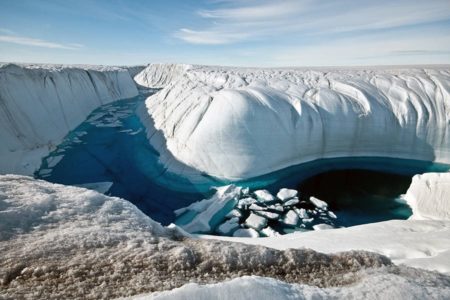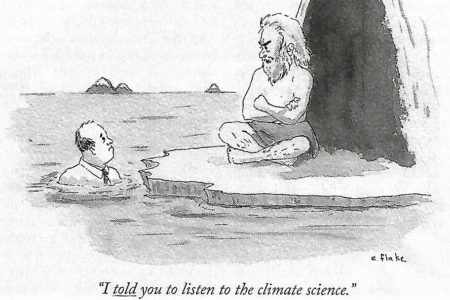December 1, 2019 – The comic appearing in a recent issue of the New Yorker seems appropriate to the subject at hand. Today in Toronto we are experiencing a winter storm that includes freezing rain, ice pellets, snow, and winds topping speeds of 70 kilometers (approximately 40 miles) per hour. It is a deadly combination of weather but not necessarily symptomatic of global warming. Or maybe it is.
Humans are only now beginning to get a handle on long-range weather forecasting, let alone understanding the larger forces at play in global climate. But scientists have been doubling down on Earth systems research in the last few decades making it more clear than ever that our planet is undergoing “unnatural” changes brought on by a new factor in the equation – us.
We hear about 97% consensus in the scientific community that we are responsible for the physical changes happening to our atmosphere, oceans, ecosystems, and weather. In the climate change denying community that supposedly gets its information from the 3% of scientists who through rigorous experimentation have proof that the 97% are wrong, the science to them remains “unsettled.” The biggest argument thrown out by these in the 3% and their supporters is that the carbon our industrial activity creates is such a tiny percentage of the entire composition of the atmosphere, how can something measured in a few hundred parts per million be so impactful?
I don’t believe the 3% of scientists are oblivious to the impact of greenhouse gases on global warming because this is pretty basic science that you and I can observe without a lot of instrumentation. Just enter a greenhouse, or stand behind a pane of glass with the sun shining in and we can experience the effect of greenhouse gases on temperature. In this case the glass acts like carbon dioxide (CO2) and other greenhouse gases. Add water vapour (H2O), another greenhouse gas and you can experience a pretty steamy indoor environment. H2O represents much more of the atmosphere than CO2, between 0.2% to 4%, and on a hot day you can experience just how much the air soaks up.
CO2 molecules absorb the energy of falling sunlight from the infrared end of the spectrum. The light energy the CO2 picks up creates an energy gain causing the molecules to vibrate and heat the oxygen and nitrogen molecules in their vicinity. Those two gases constitute over 90% of our atmosphere and neither absorb infrared radiation. So a very small percentage of atmosphere containing CO2 significantly impacts the remaining 90%.
CO2 and H2O aren’t the only greenhouse gases. Add methane (CH4), nitrous oxide (N2O), hydrofluorocarbon (HFC), perfluorocarbon (PFC) and sulphur hexafluoride (SF6) and you have the seven most potent contributors to the warming of the other 90% of molecules that constitute our atmosphere. CO2 and CH4 naturally occur. Even N2O can be found in nature. But the others are creations of our modern industrial civilization. And the prior three produced in nature are being enhanced by significant contributions from our industrial activity.
So small component parts in the atmosphere can have huge consequences. The 97% of scientists who get it tell us that we are causing global warming and that the change is happening all around us. I don’t know what the 3% are seeing but it certainly isn’t based on understanding molecular chemistry, and energy. We can forgive the fact that the average person may not understand the chemistry involved, but the scientist, no way. And we can’t forgive our political leaders from not listening to the science and scientists that have been more than forthright in sharing the evidence gathered over the last five decades.
The scientists have been methodical in summarizing the evidence. They have gathered the data. They have created numerous climate models populating each with observed data and variables to try and forecast the future. Creating an Earth-systems model is an enormous undertaking. That’s why there is not one but many different models that attempt to parse the whole, to understand the interconnectedness of the hundreds of thousands of gathered data points. In the last decade, the refining of these models and the data collection from the physical changes occurring on the planet have created new concerns about a phenomenon named tipping points, an expression first conceived by physicists and later adopted by sociologists and economists, and author Malcolm Gladwell who wrote a book with those words in the title.
Tipping Points in the World of Climate Change
The IPCC, the United Nations’ organized body that reports on climate change, introduced tipping points as something that could happen to climate. Climate tipping points were defined as “large-scale discontinuities” that would lead to accelerated change. When first conceived it was thought that climate tipping points would become an issue when the atmosphere warmed above 5 Celsius (9 Fahrenheit). So keeping the warming to between 1 and 2 Celsius (1.8 and 3.6 Fahrenheit) wouldn’t create accelerated and irreversible global climate change.
At least that’s what was originally thought in the first few IPCC reports. But no longer. The 2015 Paris Climate Agreement called for an upper warming limit of 2 Celsius (3.6 Fahrenheit) with a preferred limit to 1.5 (2.7 Fahrenheit). It was thought the margin of error in the upper limit would not create an accumulated impact leading to one or more climate tipping points.
The latest reports backed by the 97%, however, are adamant that humanity has to keep the warming to no higher than 1.5.
Why?
Three significant large-scale discontinuities with global consequences are now of considerable concern to climatologists.
Cryosphere Tipping Points
Antarctica is the place where multiple tipping points are seen as more likely than naught. First, there is West Antarctica where the continental ice sheet could become destabilized causing a domino effect and a 3-meter (over 10-foot) rise in global sea levels within a few centuries. The study of the paleo-climate of Antarctica shows evidence that collapses in West Antarctica have repeatedly happened. Second, there is East Antarctica where the Wilkes Basin is seen as unstable and conceivably contributing to another 3 to 4 meters (1o to 14 feet) of sea-level rise in a few centuries.
Greenland is melting faster and could add 7 meters (23 feet) to global sea levels by the end of the millennia. The latest research points to the impact of a 1.5 Celsius (2.7 Fahrenheit) rise in global temperatures which could happen by 2030 and doom Greenland to a runaway melting.
The bottom line is impacting generations in the future to sea-level rises totaling 14 meters (45 feet). The 1.5 Celsius (2.7 Fahrenheit) rise would yield such a result in 10,000 years. A 2 Celsius (3.6 Fahrenheit) rise would produce similar results in 1,000 years.
A summer ice-free Arctic Ocean is considered highly likely with a 2 Celsius (3.6 Fahrenheit) rise.
Biosphere Tipping Points
Coral bleaching on the Great Barrier Reef has reached 50% in shallow water areas. This is just the beginning of what is predicted to be a 99% loss of tropical corals should global temperatures rise 2 Celsius (3.6 Fahrenheit). The loss of the corals will be accompanied by the loss of flora and fauna that thrive in coral ecosystems.
The deforestation of the 7-million square kilometer (2.7-million square mile) Amazon Basin has reached 17% from where it was in 1970. Scientists cannot yet concur on whether a loss of 20% or 40% would doom the planet to a post-Amazon world. But one thing that they all agree upon is the importance the Amazon places for global climate stability. The Amazon produces 20% of the planet’s freshwater. Evaporation from the Amazon and subsequent condensation elsewhere regulate the global climate. The Amazon also recycles up to 80% of the water each tree emits to the atmosphere daily. A single tree evaporates 1,000 liters (264 US gallons) daily. The H2O release is described as a flying river in the atmosphere. Imagine the loss of the stability the Amazon brings to global climate and you will see a world where droughts and wildfire outbreaks will be more frequent. Finally, there is the loss of the Amazon’s two other assets, its biodiversity, and its carbon sink potential.
Permafrost melt in Siberia and North America is already going through an irreversible thaw as the Arctic warms up twice as fast as the rest of the planet. The permafrost containing stored carbon and methane could dramatically increase atmospheric warming and the release of greenhouse gases that would negate the gains from industrial decarbonization.
Cascading Tipping Points
A change to the Arctic Ocean sea-ice and Greenland ice sheets because of unprecedented warming is causing changes in the Atlantic Meridional Overturning Circulation (AMOC), the engine responsible for The Gulf Stream which travels from the Gulf of Mexico to Europe. As land and sea ice melt in the Arctic it is introducing surface freshwater to the North Atlantic which is causing AMOC to slow down. The first of a number of cascading consequences that include the weakening of the West African monsoon, increased drought conditions in the Sahel, disruption of the Indian Ocean monsoon, a heat build-up in the South Atlantic, and the subsequent acceleration in Antarctic sea ice and ice sheet melt.
Paleo-climate records show that such cascading tipping points have happened in the past in the cycles of the Pleistocene series of ice gains and retreats all the way until about 80,000 years ago. Again, the events that occurred at that time had no link to human activities. This time it will be different.










